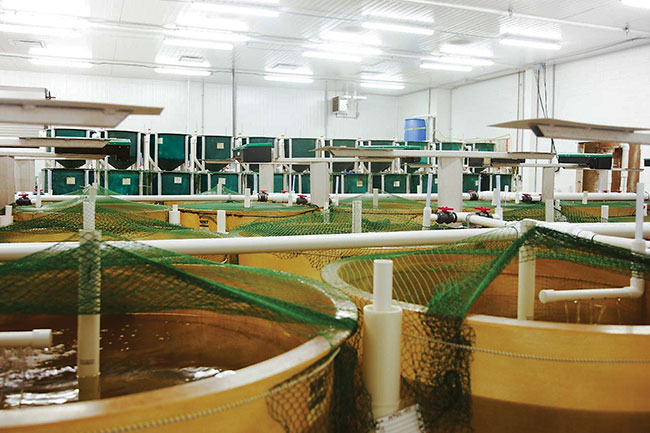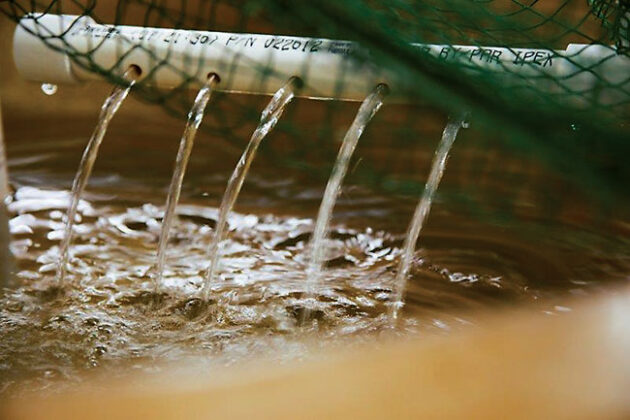
Features
Research
Micromanaging your microbiome
Moving from reactive to proactive bacterial solutions in RAS
May 23, 2023 Sponsored by The Center For Aquaculture Technologies 

The wisdom gleaned from decades of aquaculture tells RAS operators that it is better to deal with problems when they are small, as opposed to letting them grow. In RAS, the growth you don’t want, such as populations of unwanted bacteria, can result in problems with the performance and quality of your aquatic organisms. High rearing densities, the recirculation of contaminated water, and the fact that the problem is bacterial means that often you can’t even see the growing problem until it has resulted in a negative outcome: disease, off-tasting flesh, or even mortality.
The world is witnessing a rapid expansion of RAS for grow-out of aquatic organisms. This emerging practice is coming with a whole host of new challenges. An example of a prominent bacterial issue that challenged early endeavours into full life-cycle RAS culture for food production was the infamous off-flavour bacteria. Pre-harvest purging is the most common solution employed to combat this issue, which is costly and time consuming. Considering this, extensive research is being carried out to find a more proactive solution to this bacterial issue.
It is certainly worth pointing out that not all bacterial growth in RAS is unwanted. The microbiome of any RAS system is composed of a full suite of beneficial microorganisms in balance with their environment. A healthy microbiome is one that is in equilibrium; microbes grow alongside one another, and the populations of unwanted bacteria are kept in check by balanced populations of beneficial bacteria and environmental factors. For example, in a healthy RAS system, conditions encourage the adequate growth of nitrifying bacteria. However, a change in conditions or the introduction of a new variety of unwanted bacteria can push this microbiome out of equilibrium, and these unwanted bacterial populations can begin to grow beyond acceptable limits.

There are effective methods of controlling the growth of unwanted bacterial populations after it has occurred. However, many of these solutions come with challenges as well. Antibiotic use for disease, for example, has financial and public-perception costs. Regular checks on the status and makeup of one’s RAS microbiome are an effective method for identifying potential bacterial issues before they result in a negative outcome.
Traditional sampling of the microbiome involves identifying which bacteria you believe could be the source of your issue. Samples from the RAS are collected, placed under conditions for the growth of bacteria, and then the bacteria is identified using microbiological laboratory methods. This process is less than ideal for a few reasons. First, some types of bacteria are very difficult, or impossible, to culture. Small errors in sample handling and culture can result in false negatives. Second, it’s very difficult to narrow your results down to a specific species and to estimate how abundant that species is compared to others in the system. Finally, it is a slow process. A regular, effective testing regime, of any design, is one that gives you results in a time frame that allows you to act before an issue arises. So how can operators efficiently keep tabs on their RAS microbiomes?
One alternative the aquaculture industry can use is to regularly check the status of their microbiome by using a Microbiome Sequencing service. Microbiome Sequencing uses the bacterial DNA collected in samples to rapidly identify and quantify species of bacteria present in RAS microbiomes, with a higher degree of accuracy than traditional bacterial culture. Through this service, a producer can move from sampling to delivery of results in a matter of days. This short turnaround time opens the door for a regular microbiome testing regime. By carrying out such testing regularly, operators can build a baseline profile of their RAS microbiome, which enables them to identify problems early and implement targeted solutions in their systems. As well, it offers operators and researchers alike an efficient tool to aid in research into streamlined bacterial solutions, such as proactive off-flavour bacterial remedies. Dr. Adriana Artiles, business development manager for Genetics at the Center for Aquaculture Technologies (CAT), suggests that clients carry out Microbiome Sequencing monthly, as a minimum, although the suggested monitoring period can vary from system to system. Microbiome Sequencing (a service offered by CAT) can, “characterize the community of bacteria and archaea in any sample,” says Dr. Artiles.
 A stable and productive ecosystem is not much more than many organisms interacting in equilibrium, and a RAS mirrors that larger picture. A RAS microbiome that is in equilibrium is crucial to the efficient rearing of organisms in that system. Conversely, a microbiome that is in disequilibrium causes production challenges. CAT’s Microbiome Sequencing offers the ability to identify disequilibrium early, allowing operators to course-correct before a negative issue emerge.
A stable and productive ecosystem is not much more than many organisms interacting in equilibrium, and a RAS mirrors that larger picture. A RAS microbiome that is in equilibrium is crucial to the efficient rearing of organisms in that system. Conversely, a microbiome that is in disequilibrium causes production challenges. CAT’s Microbiome Sequencing offers the ability to identify disequilibrium early, allowing operators to course-correct before a negative issue emerge.
Print this page
Advertisement
- Pre-treatment of R. okamurae enhances diet suitability in juvenile European sea bass
- Benchmark Genetics Chile receives disease-free certification for salmon eggs





